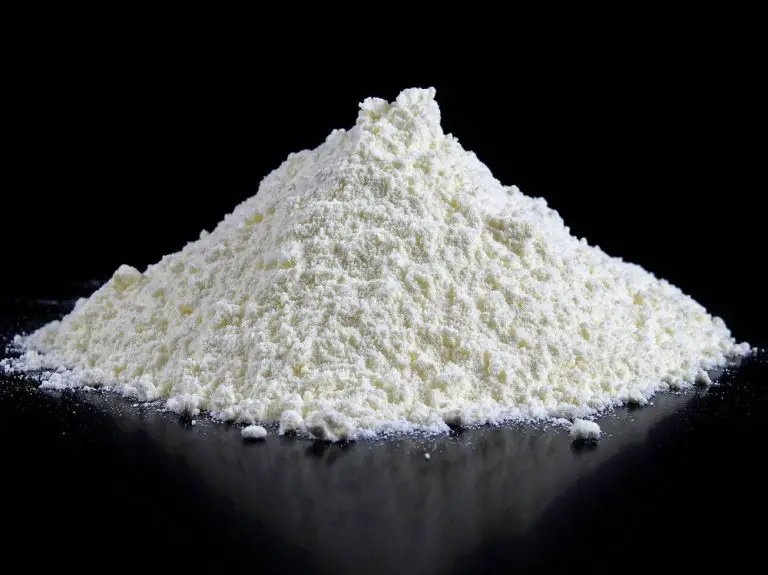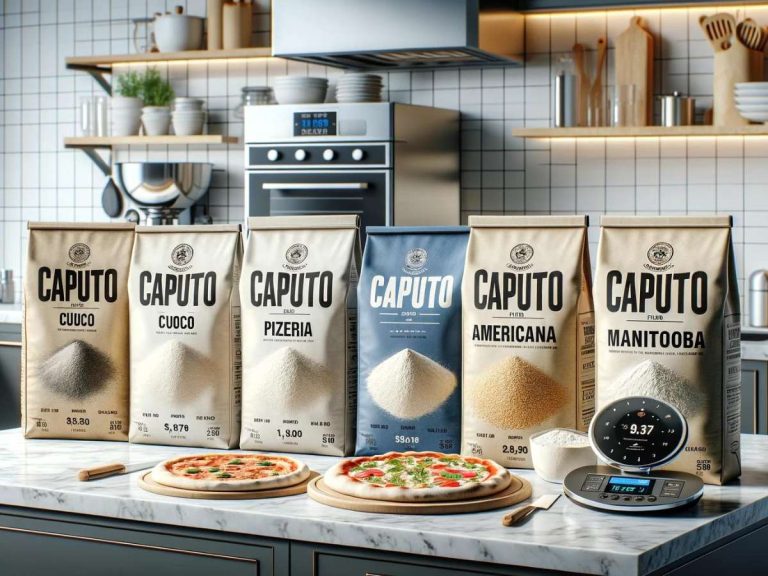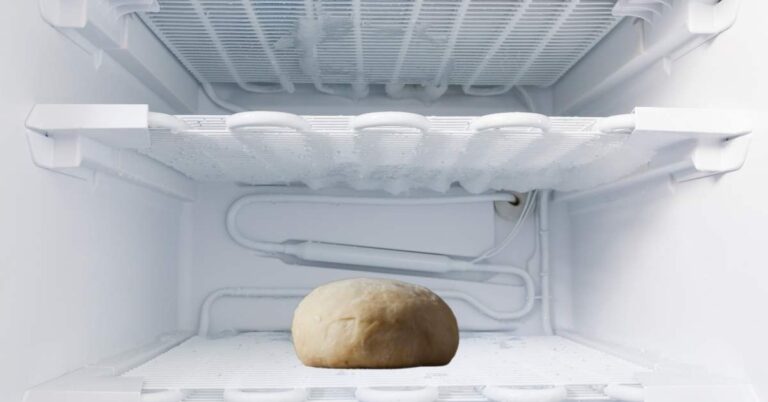All-Purpose vs 00 Flour: Differences Explained
In the world of baking, flour matters—especially when it comes to pizza. Your choice of flour can make the difference between a light and delicate crust, and a chewy and crispy one.
Among the many options out there, two types immediately come to mind: all-purpose flour and 00 flour. Both have their strengths, their fan bases, and their ideal uses.
But with pizza specifically, which flour is the best? That’s the aim of this article. Hopefully when you’re done reading it, you’ll understand the differences between all-purpose vs 00 flour, as well as the ideal times to use both.
In a nutshell: Tipo 00 flour has a finer grain, which produces a softer crust. All-purpose flour has a larger grain, with generally less protein, producing a more generic crust in terms of taste and texture. Keep reading to learn more.
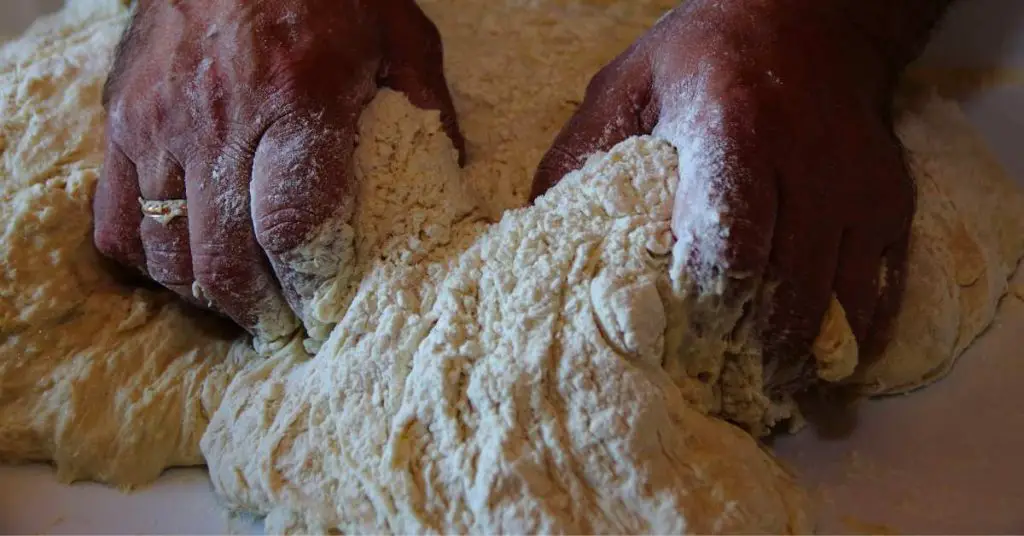
Understanding Flours: A Brief Overview
Flour, at its core, is the result of grinding grains, seeds, or roots into a fine powder. It’s a staple in kitchens worldwide, serving as the foundation for countless recipes. But not all flours are created equal. Their differences lie in their origins and the processes they undergo.
The primary source for most flours is wheat, a cereal grain known for its versatility in baking. Within a wheat kernel, there are three main components: the bran, the endosperm, and the germ.
The bran is the outer layer, packed with fiber and minerals. It gives whole wheat flour its characteristic brown hue and earthy flavor. The endosperm, the largest part of the kernel, is rich in starch and protein. It’s the primary component in white flours. Lastly, the germ is the nutrient-dense core, brimming with oils, vitamins, and minerals.
Related Post: 00 Flour vs Bread Flour
| Feature/Characteristic | 00 Flour | All-Purpose Flour |
|---|---|---|
| Origin | Italian flour, often used for pasta and pizza. | Commonly used in the U.S. and many other parts of the world for a variety of baked goods. |
| Texture | Very fine and powdery. | Slightly coarser than 00 flour but still quite fine. |
| Protein Content | Typically around 11-12.5%. | Ranges from 10-12%. |
| Best Uses | Neapolitan-style pizzas, pasta, some pastries. | Breads, cookies, cakes, pies, and more. Versatile for many baked goods. |
| Water Absorption | Higher due to its fine texture. May require more water in recipes. | Moderate. Standard in many recipes. |
| Baking Temperature | Performs best at high temperatures, especially for pizzas. | Versatile; can handle a range of temperatures. |
| Elasticity | Highly extensible, making it easier to stretch and shape. | Less extensible than 00, but offers good elasticity. |
| Flavor | Mild, allowing toppings to shine. | Neutral, making it a versatile choice for various dishes. |
| Cost | Often more expensive, especially if imported. | Generally more affordable and widely available. |
| Shelf Life | Best when fresh. Store in a cool, dry place. | Longer shelf life. Store in a cool, dry place. |
When making white flour, the bran and germ are removed, leaving only the endosperm. This results in a lighter texture and color but also strips away many nutrients. Whole wheat flour, on the other hand, incorporates all three parts, offering a denser texture and a richer nutrient profile.
As we delve deeper into the world of flours, especially the nuances between all-purpose and 00 flour, understanding these basics sets the stage for a more informed exploration.
What is 00 Flour?
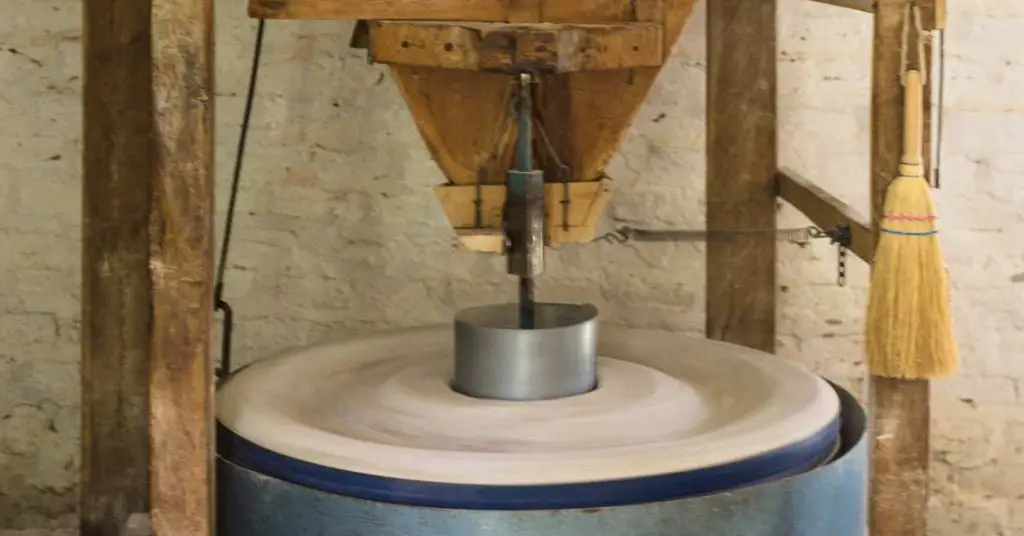
00 flour, often referred to as “doppio zero” in its native Italy, is a finely milled flour that’s prized for its soft texture and high extensibility. Originating from European wheat, it’s named after the grading system used in Italy, where flours are categorized by numbers based on their grind size. The “00” grade signifies the finest grind, resulting in a powder-like consistency.
This unique texture is achieved through a meticulous milling process that grinds the wheat multiple times. The outcome is a flour with incredibly fine particles, which allows it to absorb water rapidly and form a smooth, elastic dough.
In the culinary world, 00 flour is often associated with Italian dishes. From silky pastas to delicate pastries, its versatility is evident. However, its most iconic use is in crafting the perfect Neapolitan pizza crust. The flour’s fine texture ensures a soft, tender crust with a slight crispiness, making it a favorite among pizza enthusiasts.
While 00 flour has gained global recognition, it’s essential to understand its characteristics and best uses, especially when comparing it to other flours like all-purpose.
All-Purpose Flour: The Jack of All Trades
All-purpose flour is a versatile workhorse of a flour, making it suitable for a wide range of recipes. Made primarily from hard and soft wheat, it strikes a balance between protein content and starch.
Unlike 00 flour, which boasts a super-fine texture, all-purpose flour has a medium grind. This gives it a slightly coarser feel, but it’s still fine enough to produce tender baked goods. Its balanced protein content, typically around 10-11%, ensures a moderate gluten formation, which is ideal for different kinds of baking.
One of the biggest advantages of all-purpose flour is simply that it’s easy to find. Most grocery stores (even small corner stores) carry all-purpose flour if nothing else. So no matter what you’re baking, all-purpose flour is often the first pick simply because it’s already there.
However, while it’s definitely versatile, understanding when and where to use it is crucial.
The Key Differences: 00 Flour vs All-Purpose Flour
While both 00 flour and all-purpose flour originate from wheat, their grind size, protein content, and best uses set them apart. Let’s break down these distinctions:
- Grind Size & Texture:
- 00 Flour: As previously mentioned, 00 flour undergoes a fine milling process, resulting in a powder-like consistency. This fine grind allows it to absorb water quickly, leading to a smooth and elastic dough.
- All-Purpose Flour: This flour has a medium grind, which gives it a slightly coarser texture compared to 00 flour. However, it’s still fine enough to produce tender baked goods.
- Protein Content & Gluten Formation:
- 00 Flour: Typically has a protein content ranging from 11-12.5%, which is conducive to a soft, extensible dough. This makes it ideal for dishes that require a delicate touch, like Neapolitan pizza.
- All-Purpose Flour: With a protein content around 10-12%, it strikes a balance that allows for moderate gluten formation. This versatility is why it’s a favorite for various baking needs, from bread to pastries.
- Best Uses:
- 00 Flour: Perfect for Italian dishes, especially Neapolitan pizza, due to its soft texture. It’s also used in pastas and pastries.
- All-Purpose Flour: Its “middle of the road” nature makes it great for different kinds of recipes. Whether it’s bread, cookies, or even pizza, all-purpose flour can handle it. It’s not outstanding at anything, but it’s usually good enough.
Understanding these differences is crucial, especially when substituting one flour for the other. Each flour brings its unique characteristics to the table, influencing the texture, flavor, and overall outcome of the dish.
Pizza Showdown: All-Purpose vs 00 Flour
When it comes to making pizza, the choice between 00 flour and all-purpose flour can greatly influence the final crust. Both flours have their strengths, but their differences lend themselves to distinct pizza styles.

- 00 Flour and the Neapolitan Pizza:
- Originating from Naples, Italy, the Neapolitan pizza is known for its soft, tender crust with a slight crispiness on the outside. 00 flour is the key factor behind this iconic texture.
- The rapid water absorption of 00 flour ensures a smooth dough, which, when baked at high temperatures, results in a crust that’s airy on the inside and crispy on the outside.
- All-Purpose Flour and the Versatile Crust:
- All-purpose flour’s balanced protein content makes it a versatile choice for various pizza styles. Whether you’re aiming for a thin crust or a thicker, chewier base, all-purpose flour can deliver. It’s not great at anything, but more of a jack of all trades.
- Its moderate gluten formation ensures a crust that’s both tender and sturdy, capable of holding a generous amount of toppings without becoming soggy. The dough won’t be as strong as when using 00 flour, or even bread flour.
- Personal Preferences and Experimentation:
- While traditional recipes might lean towards one flour over the other, personal preference always plays a significant role. Some people swear by 00 flour for its authentic touch, while others prefer the adaptability of all-purpose flour.
- Experimenting with different ratios and blending flours can lead to a crust that hits all the right notes for your palate.
In the end, the best flour for pizza is subjective and depends on your tastes and preferences. Understanding the strengths and characteristics of each flour can help you figure out which one you like the best.
Substituting One Flour for the Other: What to Expect
Substituting flours in recipes can lead to some interesting and unique results, but it’s important to understand the potential outcomes first. Whether you’re out of a specific flour or just want to experiment, here’s what you can anticipate when swapping 00 flour and all-purpose flour:
- Texture and Consistency:
- Using 00 Flour in Place of All-Purpose: Expect a softer, more extensible dough. Baked goods might have a more varied crumb and a slightly crispier exterior, especially noticeable in pizzas and pastries.
- Using All-Purpose Flour in Place of 00: The result will usually be a bit coarser in texture. Pizzas might have a chewier crust, and pastries might not be as delicate.
- Water Absorption:
- 00 Flour: Because of its fine grind, 00 flour tends to absorb water more rapidly. When substituting, you might need to adjust the liquid content in the recipe slightly to achieve the desired dough consistency.
- All-Purpose Flour: It doesn’t absorb water as quickly as 00 flour. If replacing 00 flour with all-purpose in a recipe, be prepared to tweak the liquid quantities.
- Flavor and Color:
- Both flours are derived from wheat, so there won’t be a drastic change in flavor. However, the subtle differences in grind and protein content can influence the final taste and color of the baked product.
- Adjusting Baking Times and Temperatures:
- Due to the differences in protein content and grind size, baking times and temperatures might need slight adjustments. For instance, pizzas made with 00 flour often benefit from higher baking temperatures to achieve that perfect crispy exterior.
While substituting one flour for the other can be fun, it’s important to be flexible and open-minded. Small tweaks to the recipe can make all the difference in achieving the desired results.
The Global Pizza Scene: How Flour Choices Vary
Pizza is made and eaten all over the world. Each region has put its unique spin on this classic, and the choice of flour plays a big role in these adaptations.
- Italy – The Birthplace of Pizza:
- Neapolitan Pizza: As previously discussed, 00 flour is the star here, giving the crust its signature softness with a crispy exterior.
- Roman Pizza: Known for its thicker, focaccia-like base, this style often uses a blend of flours, including all-purpose and bread flour.
- United States – A Melting Pot of Pizza Styles:
- New York-Style: Thin and crispy, this iconic pizza often leans on high-protein flours like bread flour. However, all-purpose flour is also commonly used.
- Chicago Deep Dish: With its thick, pie-like crust, all-purpose flour is a popular choice, providing the necessary strength without being too chewy.
- Australia – A Fusion of Flavors:
- Australian pizzas often feature unique toppings like kangaroo or emu. The crust is usually thin and crispy, and made using all-purpose flour, though 00 flour is gaining popularity among pizza traditionalists.
- Japan – A Twist on Tradition:
- Known for its “Neapolitan” pizzas, Japan has embraced 00 flour for its pizza crusts. However, they’ve also introduced innovations like the “rice flour” pizza, offering a gluten-free alternative. Japan actually has some of the most authentic Neapolitan style pizzas outside of Italy.
- India – Spicing Things Up:
- With toppings like paneer and tandoori chicken, Indian pizzas are a flavorful fusion. The crust, often slightly thicker, is commonly made using all-purpose flour, but regional variations exist.
- Brazil – Tropical Toppings and Traditional Bases:
- Brazilian pizzas, known for their unique toppings like hearts of palm or green peas, typically use all-purpose flour for their crusts, resulting in a balance between chewy and crispy.
As you can see, the choice of flour in pizzas around the world is influenced by local preferences, available ingredients, and culinary traditions. But for the most part, all-purpose is by far the most commonly used.
This makes sense when you consider how much easier AP flour is to find, as well as how inexpensive it generally is. 00 flour is most commonly used by pizza connaisseurs, or at high-end pizzerias, who appreciate its value and don’t mind paying extra for it.
Flour Tips for Aspiring Pizza Makers
The key to every good pizza lies in its crust, so the choice of flour plays a big role. Here are some flour-focused insights to guide you on your pizza-making journey:
- Blend the Best:
- Mixing flours can be a game-changer. A fusion of 00 and all-purpose flour can offer both the delicate texture of Neapolitan pizzas and the robustness of American ones. Find your blend balance!
- Hydration Hacks:
- Different flours absorb water at varied rates. 00 flour, being finely milled, might require a tad more water than all-purpose. Adjust hydration levels based on the flour’s characteristics to achieve that perfect dough consistency.
- Rest and Rise:
- The flour’s behavior during fermentation can influence the crust’s flavor and texture. Experiment with rest periods; sometimes, a longer fermentation can enhance the flour’s natural flavors.
- Stretching Strategies:
- The way you handle the dough can affect the final crust. For instance, 00 flour doughs are often more extensible and require a gentle touch, while all-purpose flour doughs might offer a bit more resistance.
- Temperature Tactics:
- 00 flour often shines at higher baking temperatures, giving that crispy exterior. In contrast, all-purpose flour might prefer a moderate oven heat. Understand your flour’s preferences to nail the bake.
- Flour Freshness:
- Always check the freshness of your flour. Fresh flour yields a better rise and flavor. Store in a cool, dry place and consider refrigerating or freezing for longer shelf life.
- Sifting Secrets:
- Sifting your flour, especially all-purpose, can introduce air, leading to a lighter crust. It also ensures there are no unwanted lumps in your dough.
- Experiment and Evolve:
- The world of flours is vast. Beyond 00 and all-purpose, there’s a spectrum of flours to explore. Each brings its unique touch to the crust. Be adventurous and try different flour types or blends.
In the art of pizza-making, the flour is both your canvas and your co-artist. Listen to its cues, respect its nuances, and together, you’ll craft pizza masterpieces.
Final Thoughts
The world of pizza-making is as vast and varied as the flours that form its foundation. Whether it’s the finely milled 00 flour, bringing with it the essence of Italian pizzerias, or the versatile all-purpose flour, a staple in many kitchens, each has its unique story to tell.
Choosing between 00 and all-purpose flour isn’t just about picking a bag off the shelf; it’s about understanding the journey of the grain and the texture it produces. It’s about recognizing the role of each flour in crafting the perfect crust and appreciating the nuances they bring to the table.
So, the next time you slide that pizza into the oven, take a moment to appreciate the flour that made it all possible. After all, behind every great pizza is a great flour.
Related Questions
Can I mix 00 flour and all-purpose flour in a single recipe?
Absolutely! Many bakers and chefs blend the two flours to harness the best qualities of both. By mixing them, you can achieve a balance between the fine texture of 00 flour and the versatility of all-purpose flour. The exact ratio can vary based on personal preference and the specific recipe, but experimenting can lead to delightful results.
I’ve heard that 00 flour is sometimes referred to as “double zero” flour. Does this mean it’s twice as refined as all-purpose flour?
The term “double zero” or “00” in 00 flour refers to the fineness of the milling and not necessarily that it’s “twice” as refined. In the Italian grading system, flours are categorized by numbers, with 00 being the finest grind. While 00 flour is indeed more finely milled than all-purpose flour, it doesn’t mean it’s double the refinement. Instead, it indicates a very fine texture, ideal for certain recipes like Neapolitan pizza.



